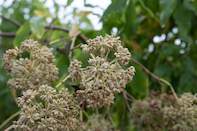The parsley tree Heteromorpha arborescens (Spreng.) Cham. and Schltdl. is a large shrub, and can grow to a small or medium sized deciduous tree which belongs to the carrot and parsley or Apiaceae family. This beautiful straggly shrub has a characteristic bark that is glossy, papery and smooth, that peels off from the stem. The faint yellow colored flowers grow in what are called umbels. The leaves have a parsley smell hence the name.

Common Names
Heteromorpha arborescens (syn. H. trifoliata)
English - Parsley tree
Zulu - Umbangandlala
Afrikaans - Wildepietersielie
The parsley tree is widely distributed in South Africa and more towards the eastern parts of the South Africa. There are four varieties of parsley tree (var. abyssinica, var. arborescens, var. collina, var. frutescens) of this variable, widely distributed tree. Heteromorpha arborescens var. abyssinica = Heteromorpha trifoliata
Parsley Tree Uses and Benefits
Heteromorpha arborescens is an important medicinal plant species throughout its distributional range in tropical Africa. The shrubby tree has many and varied uses in Zulu traditional medicine. The plant has been used by many ethnic groups in central and southern Africa and in in Southern Africa, the leaves, roots, and bark of the species are used to treat abdominal pains, asthma, colic, cough, dysentery, fever, headaches, infertility, intestinal worms, mental problems, nervous disorders, shortness of breath, and tuberculosis. Its main uses are for headaches, respiratory issues and fevers making it an ideal remedy for colds and flus.
Parsley trees uses against intestinal worms has been validated by scientific trials in the lab, and promising results have also been shown for anti-arthritic conditions and peptic ulcers from the activities of the extracts that support the traditional claims of use of the species as remedies for rheumatism and other chronic inflammatory conditions.
Researchers have found compounds from the parsley tree that have effects on the serotonergic and dopaminergic systems, that can be used as a relaxing remedy to calm the nervous system (that I can testify to from personal experimentation). Thus the parsley tree could well act as an Adaptogen to help your body adapt to stress by protecting against stress induced immune suppression and heart damage. These adaptogens also enhance brain functioning.
Other compounds in Heteromorpha arborescens have been found to have anti-inflammatory and anti-mycobacterial properties and actions that makes it a useful remedy against respiratory infections and could be a good complementary remedy to help ease respiratory infections in the case of COVID or TB.
Having relaxing and antibacterial properties makes Heteromorpha arborescens a useful short term anti-infective and stress damage control plant remedy. There is some evidence that the plant could be toxic in medium to long term use, so I would recommend its use only in cases of infection.
Plants such as the parsley tree are valuable in this time of great societal stress where there is a great need for natural relaxing remedies.
What is also needed is projects to grow such plants that are increasingly under harvesting pressure and such a project is in progress with the Khanyisa Healing Gardens Project.